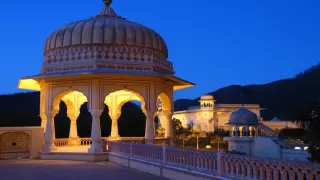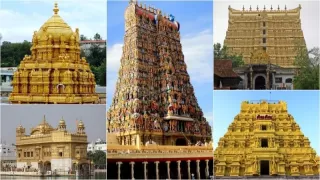India's Top 20 National Parks for Jeep Safari & Camping (2024)There's a zoo in almost every major city, but it is old to watch the animals in cages with restricted access. Seeing the animals in their natural habitat and their wild state continues to be the true joy! Thankfully, you can accomplish it at a lot of India's national parks. Camping in the outdoors beneath the stars is an additional perk of visiting such locations. Prepare yourself as we provide a list of the top national parks for camping and animal excursions.
Top 10 National Parks in India for Camping & Jeep Safari in 2024
1. Jim Corbett National Park

Image Source: Twitter
The top spot on our list should go to India's first national park, without a doubt. Situated in Uttarakhand's terai area, it was established in 1936 with the express purpose of safeguarding the Bengal tiger. Big cat territory is abundant due to the area's verdant slopes, dense forest cover, and expansive, open grasslands. Remember to pack a camera, since the park is home to over 650 different kinds of birds. Visitors can visit all five of Corbett National Park's zones: Durgadevi, Jhirna, Bijrani, Dhela, and Dikhala.
- Area: 1,318.54 square kilometres
- Prominent Mammal Species: Tiger, gharial, elephant, spotted deer, leopard, barking deer
- Other Prominent Species: Pallas’ fish eagle, crocodile, gharial
- Visiting Months: 15th November to 15th June
- Entry Fee: Rs. 200 onwards
- Nearest Railway Station: Ramnagar (1 km)
- Nearest Airport: Pantnagar airport (82 km)
2. Gir Forest National Park

Image Source: Twitter
Since the Asiatic lion, the real king of the forest exclusively lives in this region, it has to be the most unusual protected area in all of India. It is situated in Gujarat's Gir Somnath, Junagadh, and Amreli districts. It is a sizable savannah and scrub forest, similar to the sort seen in Africa, where lions live. Estimates place the number of animal species in the region at around 2,000, so nature enthusiasts will truly be in for a treat.
- Area: 1,412 square kilometres
- Prominent Mammal Species: Asiatic lion, leopard, jungle cat, striped hyena, Bengal fox, golden jackal, spotted deer, four-horned antelope, sambar, chinkara, blackbuck, wild boar, nilgai
- Prominent Bird Species: Bonelli’s eagle, tawny eagle, king vulture, crested serpent eagle, painted stork, crested hawk eagle, pelican
- Visiting Months: 16th October to 15th June
- Entry Fee: Rs. 150 onwards
- Nearest Railway Station: Junagadh (77 km)
- Nearest Airport: Sardar Vallabhbhai Patel International Airport, Ahmedabad (336 km)
3. Ranthambore National Park

Image Source: Twitter
Ranthambore National Park, one of the greatest spots in India to watch tigers, is situated in Rajasthan's Sawai Madhopur region. Machhli, the most well-known tiger in the world, flourished here; she has been in several National Geographic and Discovery Channel films. In addition, Ranthambore Fort is located inside the national park, lending historical value to the area. In addition to the several buildings inside the fort, you may be able to observe tigers, since many of them either reside here or come frequently.
- Area: 1,334 square kilometres
- Prominent Mammal Species: Tiger, spotted deer, sambar, nilgai, desert fox, chinkara, sloth bear, wild boar, golden jackal
- Prominent Bird Species: Peafowl, sarus crane, kingfisher, owl, crested serpent eagle, pelican, stork, flamingo
- Visiting Months: 1st October to 30th June
- Entry Fee: Rs. 100 onwards
- Nearest Railway Station: Sawai Madhopur (14 km)
- Nearest Airport: Jaipur International Airport (182 km)
4. Bandhavgarh National Park

Image Source: Twitter
This is another national park with a fort and one of the most well-known tourist spots in Central India. There are eight of these large animals for every square kilometre, making it one of the greatest spots in India to view tigers. In the morning and evening, jeep and elephant safaris are offered across the protected territory's four tourism zones: Magadhi, Tala, Panpatha, and Khitauli. This area's vegetation is characteristic of the Deccan Plateau, consisting of open grasslands interspersed with dry deciduous woods.
- Nearest Railway Station: Umaria (33 km)
- Area: 1,536 square kilometres
- Prominent Bird Species: Sarus crane, Egyptian vulture, crested serpent eagle, lesser adjutant, black vulture, changeable hawk eagle, white-backed vulture, long-billed vulture
- Entry Fee: Rs. 250 onwards
- Prominent Mammal Species: Tiger, leopard, sambar, nilgai, wild boar, barking deer, four-horned antelope, gaur, chinkara, Bengal fox, golden jackal, striped hyena
- Visiting Months: 25th October to 30th June
- Nearest Airport: Rani Durgawati Airport, Jabalpur (177 km)
5. Kaziranga National Park

Image Source: Twitter
Any location that receives the designation of UNESCO World Heritage Site merits exploration. Since Kaziranga is one of the remaining strongholds of the critically endangered one-horned rhino (all rhinos in Africa have two horns), the honour is much earned. The expansive, open grasslands, referred to as doors in the local tongue, are the primary characteristic of this protected area. In addition to these well-known creatures, the park is home to several other huge species, including the gaur (Indian bison), which weighs an average of 1,500 kg, the Indian elephant, and the wild water buffalo, which can be identified by its enormous horns.
- Area: 430 square kilometres
- Prominent Mammal Species: One-horned rhino, Indian elephant, wild water buffalo, gaur, swamp deer, hog deer, tiger, leopard
- Prominent Bird Species: Ruddy shelduck, bar-headed goose, kingfisher, Eurasian eagle owl, Pallas' fish eagle, Himalayan griffon, cinereous vulture
- Visiting Months: 1st November to 30th April
- Entry Fee: Rs. 50 onwards
- Nearest Railway Station: Nagaon (74.5 km)
- Nearest Airport: Lokpriya Gopinath Bordoloi International Airport, Guwahati (213 km)
Also Read: Top 10 Best Places to Visit in Rajasthan in 2024
6. Sundarbans National Park

Image Source: Twitter
One of the only locations on Earth where tigers feel as at ease swimming in rivers as they do sprinting on land is this vast swamp forest, another UNESCO World Heritage Site. This national park in India is navigable by boat rather than on foot or in a vehicle. You never know what kind of natural gem you will come to in the mangrove forest, as there are several little distributaries of the Ganga winding through it.
- Nearest Airport: Netaji Subhas Chandra Bose International Airport, Kolkata (119 km)
- Prominent Mammal Species: Tiger, leopard cat, fishing cat, fox, spotted deer
- Nearest Railway Station: Sealdah Station (115 km); Howrah Junction (124 km)
- Area: 1,330 square kilometres
- Visiting Months: November to March
- Entry Fee: Rs. 60 onwards
- Other Prominent Species: Stork, saltwater crocodile, white-bellied sea eagle, grey-headed sea eagle
7. Great Himalayan National Park

Image Source: Twitter
The Great Himalayan National Park, one of the most recent additions to the UNESCO World Heritage Site roster, captures the spirit of the tallest mountain range on Earth. Because of its elevation range of around 5,000 feet to over 19,500 feet, one may see the whole spectrum of Himalayan plants. Subtropical pine woods may be found at the lowest elevations, and they are followed by temperate coniferous forests with a predominance of fir, spruce, and deodar. The subalpine meadows and grasses ascend beyond the conifers.
- Area: 754 square kilometres
- Prominent Mammal Species: Snow leopard, Himalayan brown bear, bharal, Himalayan tahr, goral, musk deer, blue sheep, red fox
- Prominent Bird Species: Monal pheasant, lammergeier, golden eagle, Himalayan griffon vulture, eagle owl
- Visiting Months: October to June
- Entry Fee: Rs. 150 onwards
- Nearest Railway Station: Shimla (196 km)
- Nearest Airport: Shimla airport (205 km)
8. Blackbuck National Park

Image Source: Twitter
This national park in Gujarat was established, as its name implies, to save the blackbuck, a type of deer. One of the few locations in the nation to witness the Indian wolf—a distinct species from the Himalayan wolf—is another incentive to visit this protected area. This location has an abundance of tall, golden grass with few trees scattered around, in contrast to Corbett and Kaziranga, which are known for their lushness. Even though this is one of the nation's lesser protected areas, it is nevertheless very much worth seeing.
- Visiting Season: Year-round (October to March recommended)
- Entry Fee: Rs. 20 onwards
- Prominent Mammal Species: Blackbuck, Indian wolf, striped hyena, golden jackals, wild boar, nilgai, hare
- Nearest Airport: Sardar Vallabhbhai Patel International Airport, Ahmedabad (151 km)
- Nearest Railway Station: Bhavnagar (45 km)
- Prominent Bird Species: Bustard, eagle, crane, stork, falcon
- Area: 34.08 square kilometres
9. Kudremukh National Park, Karnataka

Image Source: Twitter
Kudremukh National Park is a quiet and picturesque location that is highly recommended for those who enjoy the outdoors and animals. Situated 1894 meters above sea level, the national park is part of Karnataka's Chikmagalur district. It is bordered by beautiful hills and rich vegetation, and a variety of indigenous and endangered plant and animal species may be found there. Highlights of this park include wild dogs, endangered lion-tailed macaques, and leaping leopards. Birdwatchers will also find Kudremukh to be a delight, with over 200 kinds of birds to be seen, some of which are uncommon and migratory. In addition, the park has lovely hiking paths, pure white waterfalls, verdant plantations, and natural swimming holes.
- Area: 600 square kilometres
- Prominent Mammal Species: Tiger, Malabar giant squirrel, sloth bear, barking deer, gaur, sambar, wild pig, chevrotain, muntjac
- Prominent Bird Species: Malabar whistling thrush, Malabar trogon, great pied hornbill, imperial pigeon, red-whiskered bulbul
- Visiting Months: Year-round (October to February recommended)
- Entry Fee: Rs. 200 onwards
- Nearest Railway Station: Bantawala Railway Station (28 km)
- Nearest Airport: Mangalore International Airport (91 km)
10. Keoladeo National Park, Rajasthan

Image Source: Twitter
Keoladeo National Park, an artificial bird sanctuary in Rajasthan, was once called Bharatpur Bird Sanctuary. Ornithologists and birdwatchers who frequently visit the park are treated to a feast as they may witness numerous resident and migratory birds in this stunning ecosystem, which is home to around 370 species of birds. Not only that, but certain animals, amphibians, and reptiles may also be found in Keoladeo. This bird sanctuary's 380+ plant species enhance its attractiveness and make it a must-see. There are designated walking and cycling routes throughout the park, and rickshaw pullers serve as knowledgeable tour guides. Originally used by the Maharajas as a duck shooting area in the 1800s, Keoladeo was designated as a national park in 1982 and a UNESCO World Heritage Site in 1985.
- Visiting Months: Year-round (August to November recommended)
- Nearest Railway Station: Bharatpur Junction (26 km)
- Prominent Mammal Species: Chital deer, nilgai, blackbuck, wild boar, Indian porcupine, leopard, golden jackal, striped hyena
- Area: 29 square kilometres
- Nearest Airport: Kheria Airport, Agra (56 km)
- Other Prominent Species: Basking python, painted stork, Siberian crane, greater spotted eagle, imperial eagle, cormorant, heron, spoonbill
- Entry Fee: Rs. 75 onwards
Also Read: Top 10 Best Places To Visit In Maharashtra in 2024




























